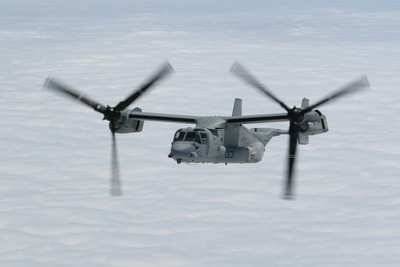First Unit Returns From 'The Sound Of The Guns'
Marine officials state the MV-22 Osprey tiltrotor aircraft has
proven itself in Iraq, and they are applying the lessons learned in
the first operational deployment of the tilt-rotor aircraft to
current operations.

"We're immensely proud of the Marines of Tilt-Rotor Squadron
263, who took on the challenging task of the first combat
deployment of the Osprey," Lt. Gen. George J. Trautman, deputy
commandant for Marine Corps aviation, said Friday.
Trautman, squadron commander Lt. Col. Paul Rock, MV-22 pilot
Capt. Sara Faibisoff, and crew chief Sgt. Danny Herrman briefed
Pentagon reporters on the squadron's deployment to Iraq. As ANN reported, the unit
deployed from Marine Corps Air Station New River, NC in September
2007; they returned last week.
Trautman said the decision to send the MV-22 to Iraq was the
right one. It gave the Marines and soldiers in Anbar province "the
best assault support aircraft" ever made, he said.
The MV-22 handled every mission it was assigned, Rock said. The
unit flew more than 2,500 sorties during its seven-month
deployment, with each of its aircraft flying an average of 62 hours
per month. Rock said before the deployment, officials forecast each
MV-22 would fly around 50 hours per month.

The aircraft was easier to maintain than the CH-46 helicopters
it replaced. The 46 is 1950s-based technology, and mechanics put in
24 hours of maintenance on those aircraft for every hour in the
air. The MV-22 took about 9.5 hours of maintenance for every hour
of flight.
The squadron deployed with 10 aircraft. "On any given day, about
seven aircraft were mission ready," Rock said. "That was more than
sufficient to meet our daily taskings."
The biggest surprise for the Marines was the vastly increased
payload and greatly increased range the Osprey brings to the
mission. Herrman said that, in loading the aircraft, he would often
run out of cubic space rather than exceeding the weight the
aircraft could handle.
The range and speed of the aircraft also were pleasant
surprises. Faibisoff told of flying a medical evacuation mission on
Christmas Day. She picked up a Marine with a ruptured appendix in a
remote base well south of Al Asad Air Base. The aircraft was able
to launch and get the Marine to medical help in 56 minutes -- well
within the "golden hour," a rule of thumb that gives an ill or
injured person the best chance for survival if treated within the
first hour of being stricken.
"We were off deck within 15 minutes of receiving the call and
headed for a zone about 90 miles south of Al Asad," she said.
Computer software makes the aircraft easy to fly, and it was
able to handle the desert environment, Faibisoff said.

The aircraft flew raid operations and scout missions, and
conducted tactical recovery of aircraft and personnel. The squadron
also flew alert missions and casualty evacuations. "The
overwhelming majority of what we did was general support -- taking
people, gear, combat equipment all over the very large battle
space," Rock said.
The combat conditions in Anbar province had improved to such a
degree that the aircraft never had to fly into a landing zone while
hostilities were under way. Still, Rock said, squadron aircraft
came under small-arms fire once and rocket fire once. "Taking
advantage of the aircraft's performance (means that) somebody's
opportunity to engage us is very short," he said.
The Marine Corps is looking at adding an all-aspect,
all-quadrant weapon on the MV-22. "The system we're looking at now
with the [US] Special Operations Command is an all-aspect weapon
that would be mounted in the belly of the aircraft," Trautman said.
The weapon will fire in any direction and be controlled by a gunner
inside the airplane.

Another MV-22 squadron is operating at Al Asad Air Base today.
The service will create two more squadrons each year.
"We're on a journey to exploit a new and revolutionary
technology," Trautman said. "We're going to continue to learn
lessons and we're going to continue to improve and we're going to
work hard to exploit the capability this aircraft."
(Aero-News thanks Jim Garamone, American Forces Press
Service)
 ANN's Daily Aero-Linx (04.16.24)
ANN's Daily Aero-Linx (04.16.24) Aero-News: Quote of the Day (04.16.24)
Aero-News: Quote of the Day (04.16.24) Airborne 04.10.24: SnF24!, A50 Heritage Reveal, HeliCycle!, Montaer MC-01
Airborne 04.10.24: SnF24!, A50 Heritage Reveal, HeliCycle!, Montaer MC-01 Airborne 04.12.24: SnF24!, G100UL Is Here, Holy Micro, Plane Tags
Airborne 04.12.24: SnF24!, G100UL Is Here, Holy Micro, Plane Tags Airborne-Flight Training 04.17.24: Feds Need Controllers, Spirit Delay, Redbird
Airborne-Flight Training 04.17.24: Feds Need Controllers, Spirit Delay, Redbird






